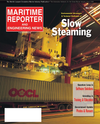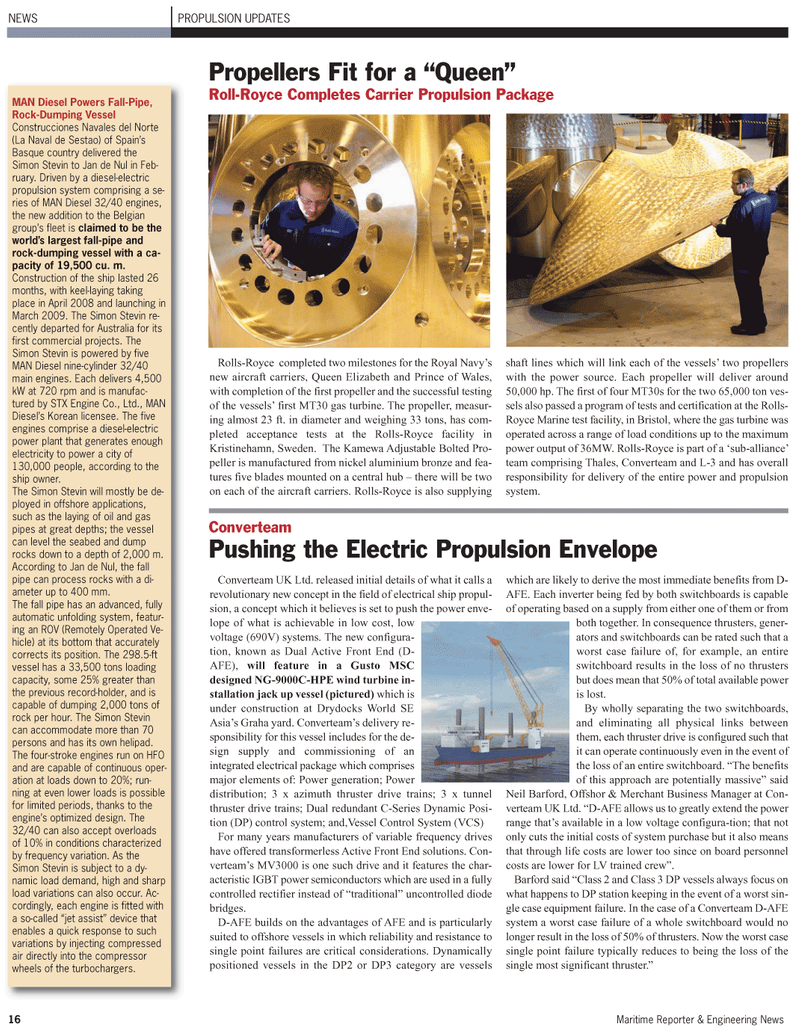
Page 16: of Maritime Reporter Magazine (May 2, 2010)
Read this page in Pdf, Flash or Html5 edition of May 2, 2010 Maritime Reporter Magazine
Rolls-Royce completed two milestones for the Royal Navy’s new aircraft carriers, Queen Elizabeth and Prince of Wales, with completion of the first propeller and the successful testing of the vessels’ first MT30 gas turbine. The propeller, measur- ing almost 23 ft. in diameter and weighing 33 tons, has com- pleted acceptance tests at the Rolls-Royce facility in
Kristinehamn, Sweden. The Kamewa Adjustable Bolted Pro- peller is manufactured from nickel aluminium bronze and fea- tures five blades mounted on a central hub – there will be two on each of the aircraft carriers. Rolls-Royce is also supplying shaft lines which will link each of the vessels’ two propellers with the power source. Each propeller will deliver around 50,000 hp. The first of four MT30s for the two 65,000 ton ves- sels also passed a program of tests and certification at the Rolls-
Royce Marine test facility, in Bristol, where the gas turbine was operated across a range of load conditions up to the maximum power output of 36MW. Rolls-Royce is part of a ‘sub-alliance’ team comprising Thales, Converteam and L-3 and has overall responsibility for delivery of the entire power and propulsion system.
NEWS PROPULSION UPDATES
MAN Diesel Powers Fall-Pipe,
Rock-Dumping Vessel
Construcciones Navales del Norte (La Naval de Sestao) of Spain’s
Basque country delivered the
Simon Stevin to Jan de Nul in Feb- ruary. Driven by a diesel-electric propulsion system comprising a se- ries of MAN Diesel 32/40 engines, the new addition to the Belgian group’s fleet is claimed to be the world’s largest fall-pipe and rock-dumping vessel with a ca- pacity of 19,500 cu. m.
Construction of the ship lasted 26 months, with keel-laying taking place in April 2008 and launching in
March 2009. The Simon Stevin re- cently departed for Australia for its first commercial projects. The
Simon Stevin is powered by five
MAN Diesel nine-cylinder 32/40 main engines. Each delivers 4,500 kW at 720 rpm and is manufac- tured by STX Engine Co., Ltd., MAN
Diesel’s Korean licensee. The five engines comprise a diesel-electric power plant that generates enough electricity to power a city of 130,000 people, according to the ship owner.
The Simon Stevin will mostly be de- ployed in offshore applications, such as the laying of oil and gas pipes at great depths; the vessel can level the seabed and dump rocks down to a depth of 2,000 m.
According to Jan de Nul, the fall pipe can process rocks with a di- ameter up to 400 mm.
The fall pipe has an advanced, fully automatic unfolding system, featur- ing an ROV (Remotely Operated Ve- hicle) at its bottom that accurately corrects its position. The 298.5-ft vessel has a 33,500 tons loading capacity, some 25% greater than the previous record-holder, and is capable of dumping 2,000 tons of rock per hour. The Simon Stevin can accommodate more than 70 persons and has its own helipad.
The four-stroke engines run on HFO and are capable of continuous oper- ation at loads down to 20%; run- ning at even lower loads is possible for limited periods, thanks to the engine’s optimized design. The 32/40 can also accept overloads of 10% in conditions characterized by frequency variation. As the
Simon Stevin is subject to a dy- namic load demand, high and sharp load variations can also occur. Ac- cordingly, each engine is fitted with a so-called “jet assist” device that enables a quick response to such variations by injecting compressed air directly into the compressor wheels of the turbochargers.
Propellers Fit for a “Queen”
Roll-Royce Completes Carrier Propulsion Package 16 Maritime Reporter & Engineering News
Converteam UK Ltd. released initial details of what it calls a revolutionary new concept in the field of electrical ship propul- sion, a concept which it believes is set to push the power enve- lope of what is achievable in low cost, low voltage (690V) systems. The new configura- tion, known as Dual Active Front End (D-
AFE), will feature in a Gusto MSC designed NG-9000C-HPE wind turbine in- stallation jack up vessel (pictured) which is under construction at Drydocks World SE
Asia’s Graha yard. Converteam’s delivery re- sponsibility for this vessel includes for the de- sign supply and commissioning of an integrated electrical package which comprises major elements of: Power generation; Power distribution; 3 x azimuth thruster drive trains; 3 x tunnel thruster drive trains; Dual redundant C-Series Dynamic Posi- tion (DP) control system; and,Vessel Control System (VCS)
For many years manufacturers of variable frequency drives have offered transformerless Active Front End solutions. Con- verteam’s MV3000 is one such drive and it features the char- acteristic IGBT power semiconductors which are used in a fully controlled rectifier instead of “traditional” uncontrolled diode bridges.
D-AFE builds on the advantages of AFE and is particularly suited to offshore vessels in which reliability and resistance to single point failures are critical considerations. Dynamically positioned vessels in the DP2 or DP3 category are vessels which are likely to derive the most immediate benefits from D-
AFE. Each inverter being fed by both switchboards is capable of operating based on a supply from either one of them or from both together. In consequence thrusters, gener- ators and switchboards can be rated such that a worst case failure of, for example, an entire switchboard results in the loss of no thrusters but does mean that 50% of total available power is lost.
By wholly separating the two switchboards, and eliminating all physical links between them, each thruster drive is configured such that it can operate continuously even in the event of the loss of an entire switchboard. “The benefits of this approach are potentially massive” said
Neil Barford, Offshor & Merchant Business Manager at Con- verteam UK Ltd. “D-AFE allows us to greatly extend the power range that’s available in a low voltage configura-tion; that not only cuts the initial costs of system purchase but it also means that through life costs are lower too since on board personnel costs are lower for LV trained crew”.
Barford said “Class 2 and Class 3 DP vessels always focus on what happens to DP station keeping in the event of a worst sin- gle case equipment failure. In the case of a Converteam D-AFE system a worst case failure of a whole switchboard would no longer result in the loss of 50% of thrusters. Now the worst case single point failure typically reduces to being the loss of the single most significant thruster.”
Converteam
Pushing the Electric Propulsion Envelope

 15
15

 17
17
